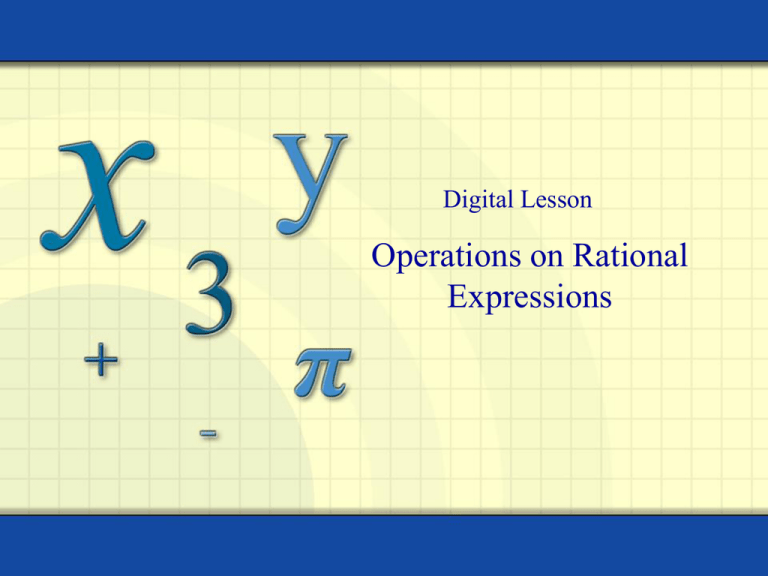
Digital Lesson
Operations on Rational
Expressions
Rational expressions are fractions in which the
numerator and denominator are polynomials and the
denominator does not equal zero.
x 9
2
Example: Simplify
x 3
.
( x 3)( x 3)
x 3
( x 3)( x 3) ,
( x 3)
( x 3) ,
Copyright © by Houghton Mifflin Company, Inc. All rights reserved.
x–30
x3
2
To multiply rational expressions:
1. Factor the numerator and denominator of each
fraction.
2. Multiply the numerators and denominators of
each fraction.
3. Divide by the common factors.
4. Write the answer in simplest form.
a c
•
b d
Copyright © by Houghton Mifflin Company, Inc. All rights reserved.
ac
bd
3
x 3x
2
Example: Multiply
x( x 3)
( x 3)( x 1)
•
x 2x 3
2
x x2
2
•
x 2x 3
2
.
( x 1)( x 2) Factor the numerator and
( x 3)( x 1) denominator of each fraction.
x( x 3)( x 1)( x 2)
( x 3)( x 1)( x 3)( x 1)
x( x 3)( x 1)( x 2)
( x 3)( x 1)( x 3)( x 1)
x( x 2)
( x 1)( x 3)
Copyright © by Houghton Mifflin Company, Inc. All rights reserved.
Multiply.
Divide by the common factors.
Write the answer in simplest
form.
4
To divide rational expressions:
1. Multiply the dividend by the reciprocal of the
divisor. The reciprocal of
a
is
b
b
.
a
2. Multiply the numerators. Then multiply the
denominators.
3. Divide by the common factors.
4. Write the answer in simplest form.
a
b
c
d
Copyright © by Houghton Mifflin Company, Inc. All rights reserved.
a d
•
b c
ad
bc
5
xx y
2
Example: Divide
2x 2x y
2
z
xx y
z
2
z
z
•
2
Factor and multiply.
2
2 x(1 xy ) • z
z
Multiply by the reciprocal
of the divisor.
2
2 x(1 xy ) • z
x(1 xy ) • z
2
2
2x 2x y
x(1 xy ) • z
.
Divide by the common
factors.
Simplest form
2
Copyright © by Houghton Mifflin Company, Inc. All rights reserved.
6
The least common multiple (LCM) of two or more numbers is the
least number that contains the prime factorization of each number.
Examples: 1. Find the LCM of 10 and 4.
10 = (5 • 2)
factors of 10
4 = (2 • 2)
LCM = 2 • 2 • 5 = 20
factors of 4
2. Find the LCM of 4x2 + 4x and x2 + 2x + 1.
4x2 + 4x = (4x)(x +1) = 2 • 2 x (x + 1)
x2 + 2x + 1 = (x +1)(x +1)
factors of x2 + 2x + 1
LCM = 2 • 2 x (x +1)(x +1) = 4x3 + 8x2 + 4x
factors of 4x2 + 4x
Copyright © by Houghton Mifflin Company, Inc. All rights reserved.
7
Fractions can be expressed in terms of the least common multiple
of their denominators.
Example: Write the fractions
x
4x
2
and
2x 1
6 x 12 x
2
in terms of the
LCM of the denominators.
The LCM of the denominators is 12x2(x – 2).
x
4x
2
x
( 2 x)(2 x)
2x 1
6 x 12 x
2
•
3( x 2)
3( x 2)
2x 1
6 x( x 2)
Copyright © by Houghton Mifflin Company, Inc. All rights reserved.
•
2x
2x
3( x 2)( x)
12 x ( x 2)
2
2 x( 2 x 1)
LCM
12 x ( x 2)
2
8
To add rational expressions:
1. If necessary, rewrite the fractions with a common
denominator.
2. Add the numerators of each fraction.
a
b
c
b
ac
b
To subtract rational expressions:
1. If necessary, rewrite the fractions with a common
denominator.
2. Subtract the numerators of each fraction.
a
b
Copyright © by Houghton Mifflin Company, Inc. All rights reserved.
c
b
ac
b
9
Example: Add
2x
14
5x
.
14
2 x 5x
14
Example: Subtract
x 4
2
Copyright © by Houghton Mifflin Company, Inc. All rights reserved.
14
2x
7x
2x 4
x 4
2
x
2
4
x 4
2
.
2( x 2)
( x 2)( x 2)
2
( x 2)
10
Two rational expressions with different denominators can be
added or subtracted after they are rewritten with a common
denominator.
x 3
Example: Add
x 2x
2
6
x 3
x( x 2)
x 3
x( x 2)
.
x 4
2
•
6
( x 2)( x 2)
( x 2)
( x 2)
( x 3)( x 2) 6 x
x( x 2)( x 2)
x 5x 6
2
x( x 2)( x 2)
Copyright © by Houghton Mifflin Company, Inc. All rights reserved.
6
•
( x)
( x 2)( x 2) ( x)
x x 6 6x
2
x( x 2)( x 2)
( x 6)( x 1)
x( x 2)( x 2)
11
Example: Subtract
x
2
x 1
2
1
x 1
2
x 1
.
2
Add numerators.
x 1
2
( x 1)( x 1)
( x 1)( x 1)
( x 1)( x 1)
( x 1)( x 1)
1
Copyright © by Houghton Mifflin Company, Inc. All rights reserved.
Factor.
Divide.
Simplest form
12







